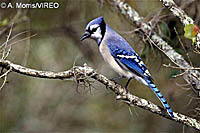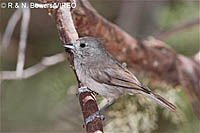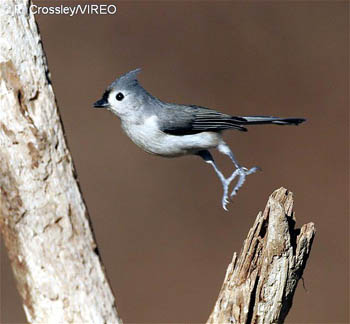Loading ...
Tufted Titmouse
The Tufted Titmouse (Baeolophus bicolor) has its roots in the south and did not expand to Massachusetts until the 1960's. The Black-crested Titmouse living only in Texas is now considered a subspecies of the Tufted Titmouse. Titmice visit feeders regularly in flocks that can include chickadees, nuthatches, and downy woodpeckers. It is an extremely vocal bird, whistling loudly and incessantly "peter, peter, peter" or "here, here, here".
See all Tufted Titmouse photosField Marks:
Titmice are the only birds with a gray crest, back and tail, and rusty flanks. The underparts are whitish. The Tufted Titmouse has a small black forehead, except that the Texas subspecies has a pale forehead and heavy black crest. The sexes are alike. (L.6.5 in.)
Distribution:
Tufted Titmice (Baeolophus bicolor) are now year-round residents across the eastern half of the United States, except extreme northern New York and New England.
Similar Species:
 |
Blue Jay (species account) (all photos) The Blue Jay is almost twice as large as the titmouse and its crest, back and flight feathers are blue with white patches on wings and tail. |
 |
Juniper titmouse (all photos) The Juniper Titmouse from the U.S. Southwest is similar, but all gray. |
Habitat & Nesting:
Titmice nest in cavities in deciduous trees often excavated by woodpeckers; Titmice infrequently use nest boxes. The Black-crested Titmouse nests in mesquite scrub.
More Information:
Titmice have a small but strong and sharp bill that they use to break into acorns and seeds held between their feet. Like chickadees, they hide seeds in tree bark and return to these caches as the season progresses. Caterpillars and other insects provide more than half of the bird's diet. Cats (domestic and feral) and hawks are major predators of titmice.

